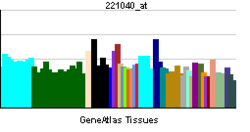CAPN10
Calpain-10 is a protein that in humans is encoded by the CAPN10 gene.[1][2]
Calpains are ubiquitous, well-conserved family of calcium-dependent, cysteine proteases. The typical calpain proteins are heterodimers consisting of an invariant small subunit and variable large subunits. The large catalytic subunit has four domains: domain I, the N-terminal regulatory domain that is processed upon calpain activation; domain II, the protease domain; domain III, a linker domain of unknown function; and domain IV, the calmodulin-like calcium-binding domain. The heterodimer interface is predominantly found between domain IV and the small subunit, which is also a calmodulin-like calcium-binding domain. This gene encodes a large subunit. It is an atypical calpain in that it lacks the calmodulin-like calcium-binding domain and instead has a divergent C-terminal domain. It therefore cannot heterodimerize with the small subunit. It is similar in organization to calpains 5 and 6. This gene is associated with type 2 or non-insulin-dependent diabetes mellitus (NIDDM) and located within the NIDDM1 region. Multiple alternative transcript variants encoding different isoforms have been described for this gene.[3]
References
- ↑ Horikawa Y, Oda N, Cox NJ, Li X, Orho-Melander M, Hara M, Hinokio Y, Lindner TH, Mashima H, Schwarz PE, del Bosque-Plata L, Horikawa Y, Oda Y, Yoshiuchi I, Colilla S, Polonsky KS, Wei S, Concannon P, Iwasaki N, Schulze J, Baier LJ, Bogardus C, Groop L, Boerwinkle E, Hanis CL, Bell GI (Nov 2000). "Genetic variation in the gene encoding calpain-10 is associated with type 2 diabetes mellitus". Nat Genet 26 (2): 163–75. doi:10.1038/79876. PMID 11017071.
- ↑ Baier LJ, Permana PA, Yang X, Pratley RE, Hanson RL, Shen GQ, Mott D, Knowler WC, Cox NJ, Horikawa Y, Oda N, Bell GI, Bogardus C (Oct 2000). "A calpain-10 gene polymorphism is associated with reduced muscle mRNA levels and insulin resistance". J Clin Invest 106 (7): R69–73. doi:10.1172/JCI10665. PMC 387246. PMID 11018080.
- ↑ "Entrez Gene: CAPN10 calpain 10".
Further reading
- Sorimachi H, Ishiura S, Suzuki K (1998). "Structure and physiological function of calpains.". Biochem. J. 328 (3): 721–32. PMC 1218978. PMID 9396712.
- Cox NJ; Hayes MG; Roe CA et al. (2004). "Linkage of calpain 10 to type 2 diabetes: the biological rationale". Diabetes. 53 Suppl 1: S19–25. doi:10.2337/diabetes.53.2007.s19. PMID 14749261.
- Turner MD, Cassell PG, Hitman GA (2006). "Calpain-10: from genome search to function". Diabetes Metab. Res. Rev. 21 (6): 505–14. doi:10.1002/dmrr.578. PMID 16028216.
- Horikawa Y (2007). "Calpain-10 (NIDDM1) as a Susceptibility Gene for Common Type 2 Diabetes". Endocr. J. 53 (5): 567–76. doi:10.1507/endocrj.KR-70. PMID 16873988.
- Nagase T; Nakayama M; Nakajima D et al. (2001). "Prediction of the coding sequences of unidentified human genes. XX. The complete sequences of 100 new cDNA clones from brain which code for large proteins in vitro". DNA Res. 8 (2): 85–95. doi:10.1093/dnares/8.2.85. PMID 11347906.
- Ma H; Fukiage C; Kim YH et al. (2001). "Characterization and expression of calpain 10. A novel ubiquitous calpain with nuclear localization". J. Biol. Chem. 276 (30): 28525–31. doi:10.1074/jbc.M100603200. PMID 11375982.
- Evans JC; Frayling TM; Cassell PG et al. (2001). "Studies of association between the gene for calpain-10 and type 2 diabetes mellitus in the United Kingdom". Am. J. Hum. Genet. 69 (3): 544–52. doi:10.1086/323315. PMC 1235484. PMID 11481585.
- Tsai HJ; Sun G; Weeks DE et al. (2002). "Type 2 diabetes and three calpain-10 gene polymorphisms in Samoans: no evidence of association". Am. J. Hum. Genet. 69 (6): 1236–44. doi:10.1086/324646. PMC 1235535. PMID 11704924.
- Woollard JR, Rothschild MF (2002). "Assignment of the porcine calpain-10 gene (CAPN10) to chromosome 15q23-26". Anim. Genet. 32 (6): 393–393. doi:10.1046/j.1365-2052.2001.0781d.x. PMID 11736815.
- Xiang K; Fang Q; Zheng T et al. (2002). "[The impact of calpain-10 gene combined-SNP variation on type 2 diabetes mellitus and its related metabolic traits]". Zhonghua Yi Xue Yi Chuan Xue Za Zhi 18 (6): 426–30. PMID 11774208.
- Elbein SC; Chu W; Ren Q et al. (2002). "Role of calpain-10 gene variants in familial type 2 diabetes in Caucasians". J. Clin. Endocrinol. Metab. 87 (2): 650–4. doi:10.1210/jc.87.2.650. PMID 11836299.
- Daimon M; Oizumi T; Saitoh T et al. (2002). "Calpain 10 gene polymorphisms are related, not to type 2 diabetes, but to increased serum cholesterol in Japanese". Diabetes Res. Clin. Pract. 56 (2): 147–52. doi:10.1016/S0168-8227(01)00372-2. PMID 11891023.
- Fullerton SM; Bartoszewicz A; Ybazeta G et al. (2002). "Geographic and haplotype structure of candidate type 2 diabetes susceptibility variants at the calpain-10 locus". Am. J. Hum. Genet. 70 (5): 1096–106. doi:10.1086/339930. PMC 447588. PMID 11891618.
- Hoffstedt J; Rydén M; Löfgren P et al. (2002). "Polymorphism in the Calpain 10 gene influences glucose metabolism in human fat cells". Diabetologia 45 (2): 276–82. doi:10.1007/s00125-001-0732-2. PMID 11935160.
- Malecki MT; Moczulski DK; Klupa T et al. (2002). "Homozygous combination of calpain 10 gene haplotypes is associated with type 2 diabetes mellitus in a Polish population". Eur. J. Endocrinol. 146 (5): 695–9. doi:10.1530/eje.0.1460695. PMID 11980626.
- Sun HX; Zhang KX; Du WN et al. (2002). "Single nucleotide polymorphisms in CAPN10 gene of Chinese people and its correlation with type 2 diabetes mellitus in Han people of northern China". Biomed. Environ. Sci. 15 (1): 75–82. PMID 12046551.
- Haddad L; Evans JC; Gharani N et al. (2002). "Variation within the type 2 diabetes susceptibility gene calpain-10 and polycystic ovary syndrome". J. Clin. Endocrinol. Metab. 87 (6): 2606–10. doi:10.1210/jc.87.6.2606. PMID 12050223.
External links
| |||||||||||||||||||||||||||||

